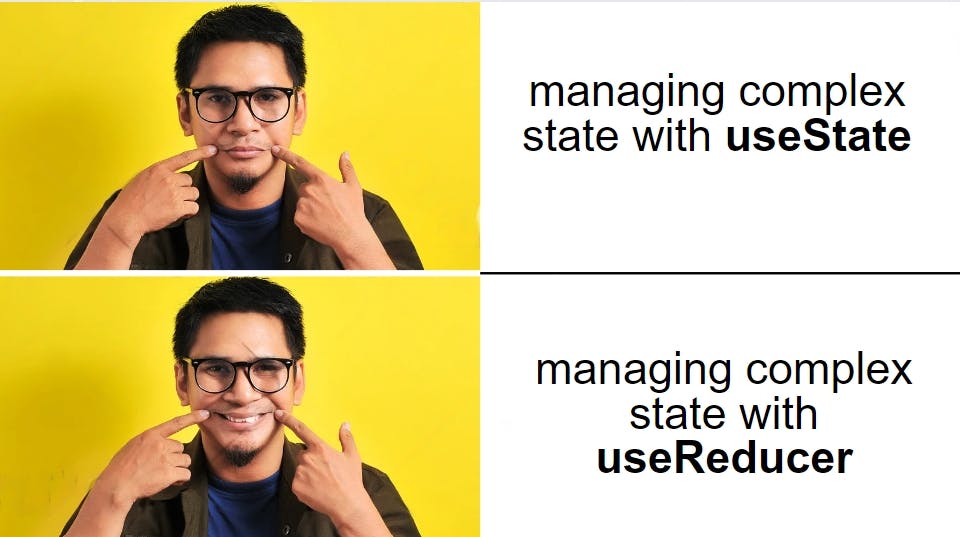Mastering React's useReducer: From Basics to Advanced Techniques
From Basics to Real-World Applications, Unleash the Power of State Management
React is the bedrock of modern web development, enabling dynamic, efficient, and scalable user interfaces. At its core lies useReducer, a formidable tool that streamlines complex state management and transforms how we handle data.
Imagine crafting a sophisticated web app with diverse components, each having unique state demands. You need a solution that not only organizes your code but also optimizes performance. Enter useReducer, poised to revolutionize your React state management approach.
In this comprehensive guide, we'll master useReducer from the ground up. Whether you're a React novice expanding your toolkit or a seasoned developer honing state management skills, you're in the right place. We'll delve into fundamentals and advance to real-world applications, equipping you to architect robust and scalable React applications. Along the way, we'll demystify syntax, explore best practices, tackle asynchronous operations, and provide an immersive learning experience. Fasten your seatbelt, as we elevate your React development skills to new heights and dive into the world of useReducer for crafting remarkable user interfaces. Ready to master React's useReducer like never before?
PermalinkUnderstanding the Need for useReducer
Before we delve into the nitty-gritty of useReducer, it's crucial to understand why it exists and when to use it. React offers another state management hook called useState, which is excellent for managing simple states in components. However, as your application grows, you might encounter situations where useState becomes less efficient and organized.
This is where useReducer shines. It's particularly useful when dealing with complex state logic, or when you need to manage multiple related state values within a single component. It provides a structured and predictable way to update and maintain state, especially when your state transitions depend on the previous state.

PermalinkSlicing through useReducer Syntax: Making the Complex Seem Easy-Peasy
Unlock the magic behind useReducer's syntax, and watch as the once complex becomes as easy as a playful game of peekaboo in your React components.
Attention, everyone! 📢 I'll break down the syntax in meticulous detail, and if you grasp this part with laser-focused attention, I can promise you that working with the useReducer hook will be a breeze. Let's dive into it together, ensuring a mistake-free journey.
Let's start by looking at the basic syntax of useReducer:
const [state, dispatch] = useReducer(reducer, initialState);
useReducer takes three arguments: reducer, initialstate, and optionally init. It returns an array with two elements: state and dispatch.
state: This represents the current state of your component, similar to whatuseStateprovides.dispatch: This is a function that you use to dispatch actions to update the state. When you call dispatch, it triggers a state update based on the action you provide. The action is processed by the reducer function, which defines how the state should change.reducerThe reducer is a pure function that defines how the state should change in response to different actions. It takes two arguments: the current state and an action, and it returns the new state. The reducer function is typically defined separately from the component and is passed as the first argument touseReducer.initialState: The starting point for your state, often an object that defines the structure of your state.
After mastering the syntax, let's delve into the step-by-step process of implementing the useReducer hook in React applications:
PermalinkStep:1️⃣ Import useReducer and React
import React, { useReducer } from 'react';
PermalinkStep:2️⃣Define Your Initial State
const initialState = {
count: 0, // Example: Initialize a count state variable
// Add other state properties here if needed
};
PermalinkStep:3️⃣ Create a Reducer Function
// i have made it clear from steps also, and again repeating that reducer takes
// two arguments
const reducer = (state, action) => {
switch (action.type) {
case 'increment':
return { ...state, count: state.count + 1 };
// Add cases for other actions...
default:
return state;
}
};
PermalinkStep 4️⃣: Use useReducer to Initialize State and Get state and dispatch
// above reducer function and initial state will be passed to the useReducer
const [state, dispatch] = useReducer(reducer, initialState);
👉state now holds your state data, and dispatch is the function you use to send actions
PermalinkStep 5️⃣: Dispatch Actions to Update State
<button onClick={() => dispatch({ type: 'increment' })}>Increment</button>
// Add more buttons and actions as needed like for decrement ...
PermalinkStep 6️⃣: Display the State in Your Component
<p>Count: {state.count}</p>
// Display other state properties as needed...
This is how your final setup for incrementing number on click will look like
//step1
import React, { useReducer } from 'react';
//step 2
const initialState = {
count: 0, // Example: Initialize a count state variable
};
////step 3
// 💡we generally have more than one reducer and we define them in seprate file
const reducer = (state, action) => {
switch (action.type) {
case 'increment':
return { ...state, count: state.count + 1 };
// Add cases for other actions...
default:
return state;
}
};
const App = () => {
//step 4
const [state, dispatch] = useReducer(reducer, initialState);
return (
<div>
<p>Count: {state.count}</p>
<button onClick={() => dispatch({ type: 'increment' })}>Increment</button>
</div>
);
};
export default App;
In our code, we have the flexibility to incorporate additional actions, such as decrementing the number when a button is clicked. If you'd like to take on the challenge of implementing this yourself by revisiting the steps and syntax we've discussed so far, go ahead! However, for your convenience, I'm providing the code snippet below as a reference.
import React, { useReducer } from 'react';
// Step 1: Define the initial state
const initialState = {
count: 0, // Example: Initialize a count state variable
};
// Step 2: Define the reducer function
const reducer = (state, action) => {
switch (action.type) {
case 'increment':
return { ...state, count: state.count + 1 };
case 'decrement': // Step 3: Define the 'decrement' action
return { ...state, count: state.count - 1 };
// Add cases for other actions here...
default:
return state;
}
};
const App = () => {
// Step 4: Initialize the state and dispatch function using useReducer
const [state, dispatch] = useReducer(reducer, initialState);
return (
<div>
<p>Count: {state.count}</p>
{/* Step 5: Add buttons to trigger actions */}
<button onClick={() => dispatch({ type: 'increment' })}>Increment</button>
<button onClick={() => dispatch({ type: 'decrement' })}>Decrement</button> {/* Step 6: Add a button for 'decrement' */}
</div>
);
};
export default App;
This Excalidraw illustration beautifully encapsulates the essence of the useReducer hook, a powerful tool in the world of React state management. Take a look and explore its capabilities in action.

PermalinkConcluding Part 1: Stay Tuned for Part 2!
This marks the completion of the first part of our journey into React's useReducer hook. We've laid a solid foundation by understanding its fundamentals and syntax. In the next installment, we'll dive deeper into real-life complex examples, showcasing the full potential of the useReducer hook. Whether you're a React novice expanding your toolkit or an experienced developer fine-tuning your state management skills, this series aims to equip you to build robust and scalable React applications.
If you found this guide helpful or have any questions, we'd love to hear from you. Please leave a like, comment, or share your thoughts below. Your support and engagement are invaluable as we continue this exploration into the world of React and state management. Stay tuned for more, and thank you for being a part of our learning journey!
